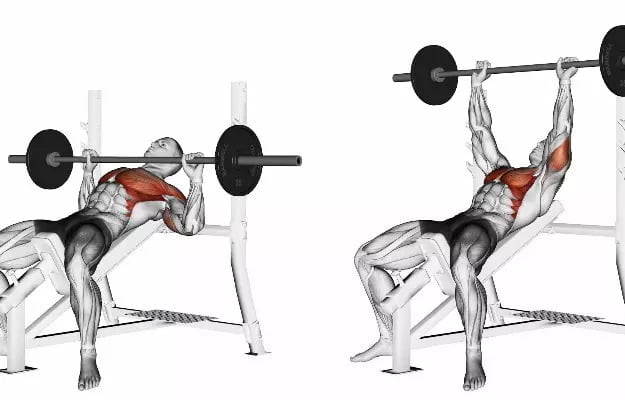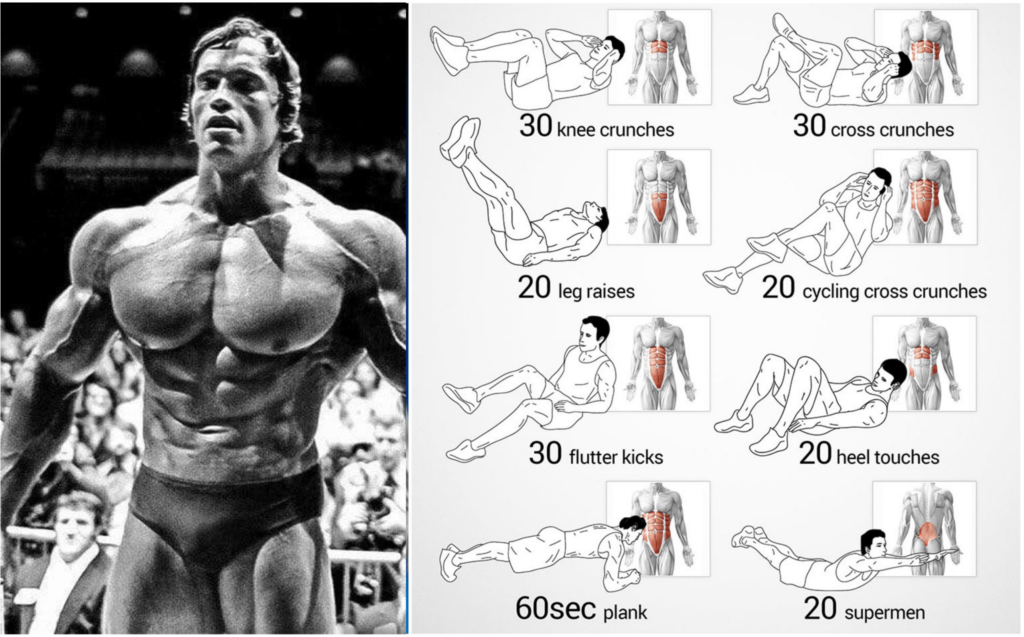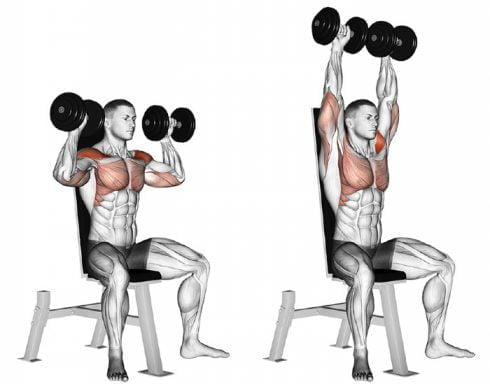Introduction
Power Up Your Bench Press is a crucial aspect of strength training for many athletes and fitness enthusiasts. The bench press is a compound exercise that primarily targets the chest, triceps, and shoulders, and is a common measurement of upper body strength.
A stronger bench press can improve overall upper body strength and muscle mass, as well as help in various athletic pursuits. The purpose of this article is to provide tips and strategies for increasing one’s maximum bench press, enabling individuals to lift heavier weights and achieve greater strength gains.
The Anatomy of the Bench Press

The bench press is a compound exercise that targets multiple muscles in the upper body. The primary muscles worked during a bench press are the chest muscles (pectoralis major and minor), the triceps, and the anterior (front) deltoids of the shoulders.
The chest muscles are responsible for horizontal adduction of the humerus, which means they bring the upper arms toward the midline of the body. The triceps are responsible for elbow extension, which means they straighten the arm. The anterior deltoids of the shoulders are responsible for shoulder flexion, which means they lift the arms up in front of the body.
How each muscle contributes to the lift and how weaknesses in specific muscles can limit one’s performance
The chest muscles are the primary movers during the bench press, and they play a crucial role in lifting the barbell off the chest. The triceps assist in the lift by extending the arms to lockout, while the shoulders stabilize the weight and help to keep the bar on the correct path.
Weaknesses in any of these muscle groups can limit one’s performance in the bench press. For example, if the chest muscles are weak, it may be difficult to lift the weight off the chest. If the triceps are weak, the lifter may struggle to lock out the weight at the top of the lift. If the shoulders are weak, it may be difficult to maintain proper form and stabilize the weight throughout the lift.
Proper form and technique for the bench press
To perform a bench press with proper form and technique, follow these steps:
- Lie flat on a bench with your feet flat on the floor and your eyes directly under the bar.
- Grip the bar with your hands slightly wider than shoulder-width apart, and make sure your wrists are straight.
- Unrack the bar and lower it slowly to your chest, keeping your elbows tucked in and your shoulder blades squeezed together.
- Pause briefly at the bottom of the lift, then press the bar back up to the starting position, keeping your elbows tucked in and your feet firmly planted on the ground.
- Exhale as you press the weight up, and inhale as you lower it back down.
- Keep your chest up, your shoulders back and down, and your lower back flat against the bench throughout the entire lift.
Strategies for Increasing Strength and Power
To increase your bench press strength and power, there are several effective training methods you can use:
- Progressive overload works by progressively challenging the muscles through gradual increases in weight or repetitions. This can be achieved by using a variety of set and rep schemes, such as 3 sets of 8-10 reps, 4 sets of 6-8 reps, or 5 sets of 5 reps. Examples of exercises that can be used to implement this method include the bench press, incline bench press, dumbbell press, and push-ups.
- Periodization works by dividing training into specific phases or periods, each with a specific goal and training style. For example, a hypertrophy phase may involve higher reps and lower weights to encourage muscle growth, while a strength phase may involve heavier weights and lower reps to focus on building strength. A power phase may involve explosive movements and plyometric exercises to improve power output. Examples of exercises that can be used for each phase include hypertrophy exercises such as dumbbell flyes and cable crossovers, strength exercises such as close-grip bench press and floor press, and power exercises such as plyometric push-ups and medicine ball chest passes.
- Accessory exercises work by targeting specific muscle groups to improve overall strength and stability. This can include exercises for the triceps, shoulders, back, and core. Examples of exercises that can be used include tricep pushdowns, overhead press, rows, pull-ups, and planks.
Importance of consistency and tracking progress over time
Consistency is key when it comes to Powering Up Your Bench Press. It’s important to stick to a regular training schedule and remain consistent with your workouts to see progress over time. Additionally, tracking your progress is crucial to identifying areas of improvement and setting realistic goals.
This can include tracking your weight, reps, and sets, as well as monitoring your form and technique. Consistently tracking your progress can help you identify patterns and adjust your training accordingly, leading to continuous improvement and better results in the long term.
Nutrition and Recovery to Power Up Your Bench Press
Proper nutrition is essential for improving one’s bench press and overall strength training performance. Consuming adequate amounts of protein, carbohydrates, and fats are important for several reasons.
Protein provides the building blocks for muscle repair and growth, while carbohydrates and fats are necessary for energy production during workouts. It is recommended that individuals consume around 1 gram of protein per pound of body weight per day, along with an adequate amount of carbohydrates and fats based on their individual needs.
It’s also important to consume enough calories to support muscle growth and repair. A balanced diet consisting of whole foods such as lean meats, whole grains, fruits, and vegetables can provide the necessary nutrients to power up your bench press.
How proper hydration and sleep can impact one’s performance in the gym?
Proper hydration and sleep play a crucial role in optimizing one’s performance in the gym, including the bench press. Dehydration can cause fatigue, muscle cramps, and a decrease in strength and power output. Therefore, it is important to stay hydrated before, during, and after workouts. A general rule of thumb is to drink at least 8 cups of water per day, or more if you are exercising regularly.
Adequate sleep is also crucial for optimal performance. Lack of sleep can lead to fatigue, decreased energy levels, and poor mental focus, which can all negatively impact one’s performance in the gym. Getting at least 7-8 hours of sleep per night can help you recover from your workouts and be ready for your next bench press session.
Tips for optimizing recovery after workouts
Optimizing recovery after a workout is essential for building strength and making progress in your bench press.
Foam rolling, stretching, and massage are all effective ways to aid in recovery. Foam rolling can help release tension in tight muscles and improve circulation, while stretching can increase flexibility and prevent injury. Additionally, massage therapy can help reduce soreness, improve circulation and aid in relaxation.
Other recovery techniques that can be helpful include taking rest days, using ice or heat therapy, and engaging in active recovery activities such as light jogging or swimming. Proper recovery is just as important as proper training, and taking the time to allow your body to rest and recover can help you power up your bench press in the long run.
Common Mistakes to Avoid
Common mistakes that can limit one’s progress in the bench press, such as improper form, overtraining and neglecting accessory exercises are important for anyone looking to improve their bench press.
Improper form is one of the most common mistakes that people make when performing the bench press. This can include arching the back excessively, bouncing the bar off the chest, or flaring the elbows out too much. These mistakes can put unnecessary stress on the joints and limit the activation of the muscles involved in the lift. To avoid these mistakes, it’s important to focus on maintaining a tight core, keeping the elbows tucked in, and controlling the descent of the bar to the chest.
Overtraining is another mistake that can limit progress in the bench press. Overtraining can occur when someone trains too frequently or with too much volume, which can lead to muscle fatigue and decreased performance. To avoid this mistake, it’s important to listen to your body and give yourself enough rest and recovery time between workouts. A good rule of thumb is to allow at least 48 hours of rest between bench press sessions.
Neglecting accessory exercises is also a common mistake that can limit progress in the bench press. Accessory exercises are exercises that target the muscles used in the bench press but are not the bench press itself. Neglecting these exercises can lead to muscle imbalances and weaknesses that can limit one’s progress in the lift. To avoid this mistake, it’s important to incorporate exercises like the overhead press, dips, and push-ups into your training program.
In order to avoid these mistakes and improve your bench press, it’s important to focus on proper form, allow enough rest and recovery time between workouts, and incorporate accessory exercises into your training program. By doing so, you can “Power Up Your Bench Press” and achieve your strength training goals.
Exercises to Improve Your Bench Press

Here are some exercises that can help improve your bench press:
- Barbell bench press: The most obvious exercise to improve your bench press is to do more bench pressing. Make sure you are using the proper form and technique, and gradually increase the weight over time.
- Incline bench press: The incline bench press targets the upper portion of the chest and shoulders, which can help increase overall strength for the bench press.
- Dumbbell bench press: Dumbbell bench press is a great way to work on stabilizing muscles in your shoulders and chest. By using dumbbells, you can also work on any muscle imbalances you may have.
- Push-ups: Push-ups are a great bodyweight exercise that can help build chest and shoulder strength. Try different variations, such as wide grip or diamond push-ups, to target different areas of your chest.
- Tricep exercises: Your triceps play a big role in the bench press, so make sure to include exercises that target them, such as tricep dips or overhead tricep extensions.
- Shoulder exercises: Strong shoulders are also important for a strong bench press. Incorporate exercises like shoulder presses or lateral raises to help build shoulder strength.
- Plyometric push-ups: Plyometric push-ups involve explosive movements that can help improve the power and speed of the bench press. Start with regular push-ups, then progress to clap push-ups or medicine ball push-ups.
- Close grip bench press: Close grip bench press focuses on the triceps and can help improve lockout strength in the bench press. Keep your hands closer together on the barbell and lower the weight slowly to your chest, then push it back up explosively.
- Resistance band exercises: Resistance bands can be a great way to work on strengthening the stabilizing muscles in your shoulders and chest. Try band pull-apart or band chest flies.
- Pull-ups: Pull-ups are a great exercise to improve overall upper body strength and can help with pulling the bar down during the bench press. Focus on doing pull-ups with proper form and gradually increase the number of reps you can do.
- Core exercises: A strong core can help with overall stability and power during the bench press. Incorporate exercises like planks, Russian twists, or weighted sit-ups to work on your core strength.
- Rest and recovery: Don’t forget that rest and recovery are just as important as the exercises themselves. Make sure to give your muscles time to recover between workouts and get enough sleep to ensure proper recovery.
Remember to always use proper form and technique, and gradually increase the weight and intensity over time. Also, make sure to give your muscles time to rest and recover between workouts.
Can I Train In Bench Press Every Day?
It is not recommended to train bench press every day, as this can lead to overuse injuries and a plateau in your progress. The bench press is a compound movement that involves multiple muscle groups, including the chest, shoulders, triceps, and back. These muscles need time to rest and recover between workouts in order to build strength and prevent injury.
Most experts recommend training the bench press 2-3 times per week, with at least one day of rest in between each workout. This allows for adequate recovery time and helps prevent overuse injuries. You can still train other muscle groups on the days you do not bench pressing to maximize your overall progress.
It’s also important to vary your bench press workouts and incorporate different exercises and techniques to prevent plateauing and keep your muscles challenged. If you want to improve your bench press, focus on progressive overload and gradually increase the weight you’re lifting over time while maintaining proper form and technique.
Conclusion
In conclusion, this article has provided strategies and tips to help you power up your bench press and increase your maximum lift. We covered the anatomy of the bench press and the importance of proper form and technique. We also discussed various training methods, such as progressive overload and accessory exercises, that can help you build strength and power in the muscles involved in the bench press. Additionally, we emphasized the importance of proper nutrition, hydration, and recovery in maximizing your progress.
We encourage you to apply the strategies discussed in this article to your own training regimen and to track your progress over time. Remember to be patient and consistent, and don’t be afraid to challenge yourself with heavier weights as you get stronger. By incorporating these tips into your routine, you can take your bench press to the next level and reach new heights of strength and power. So, power up your bench press and keep striving towards your fitness goals!

Good day, and welcome to Fitthour. My name is Shubham Vijay, and I am a certified personal trainer and nutrition coach with 6 years of experience in the fitness industry. At Fitthour, we specialize in types of training, such as strength training, cardio, or HIIT, and our mission is to help clients achieve their fitness goals and improve their overall health.




